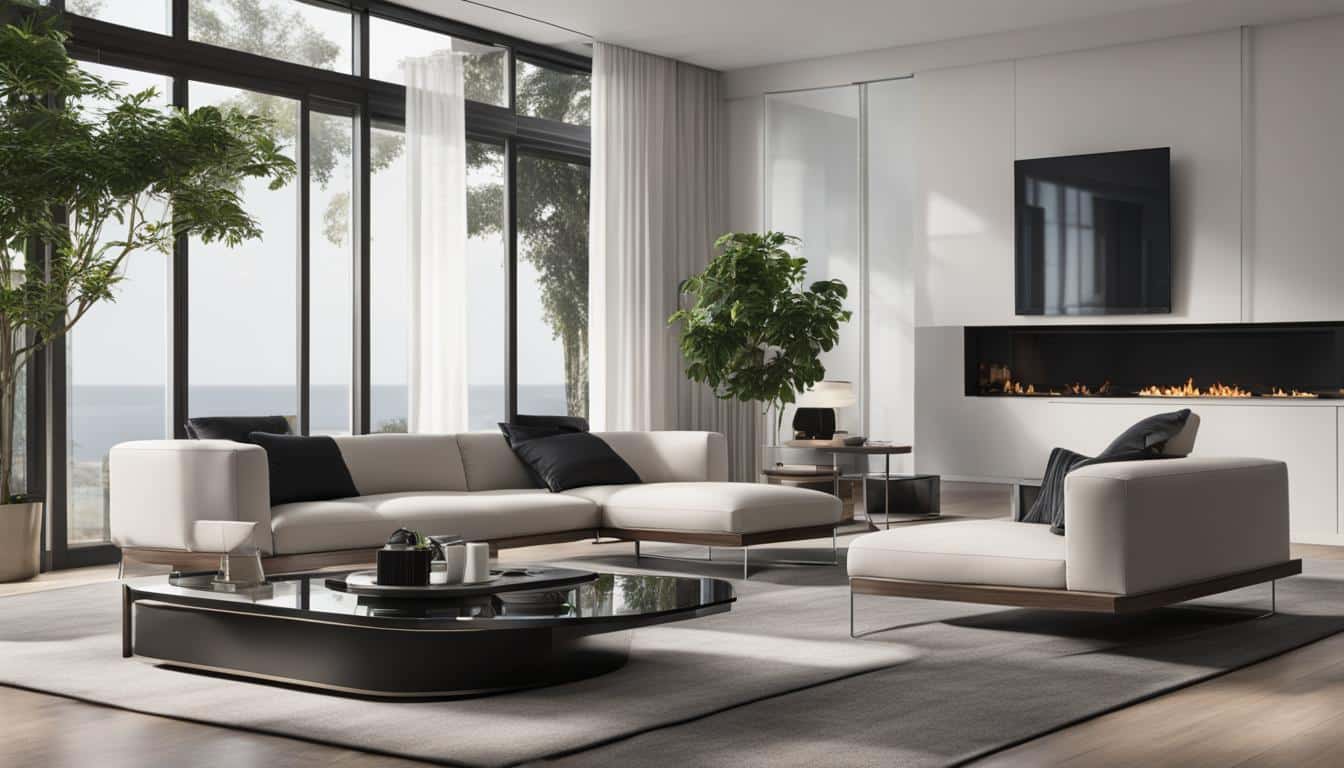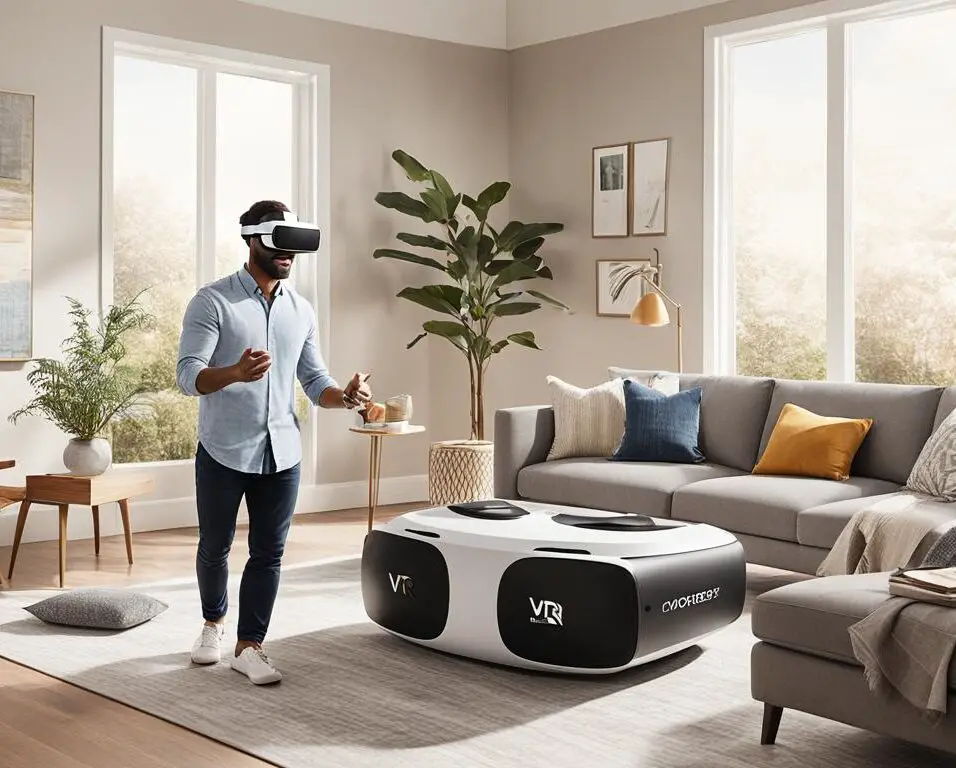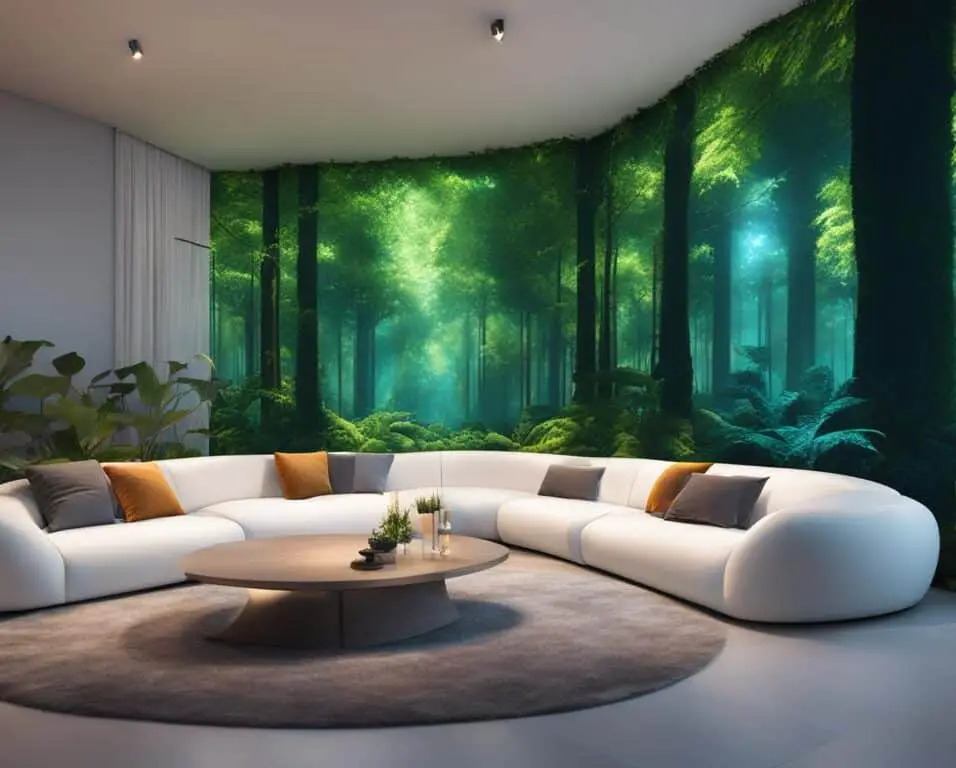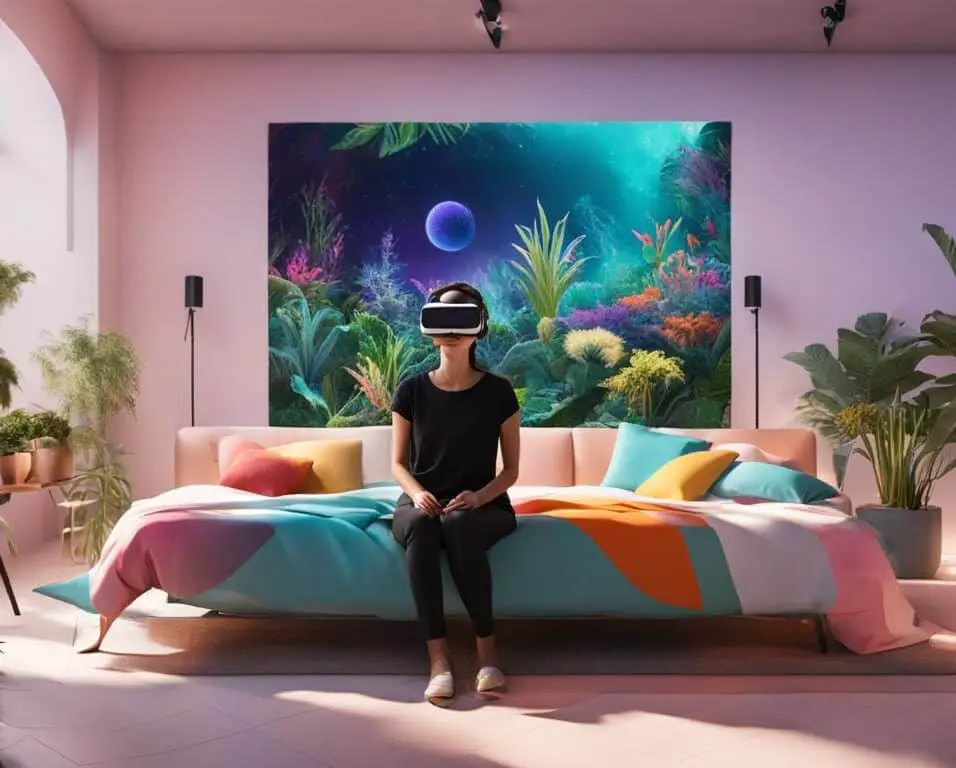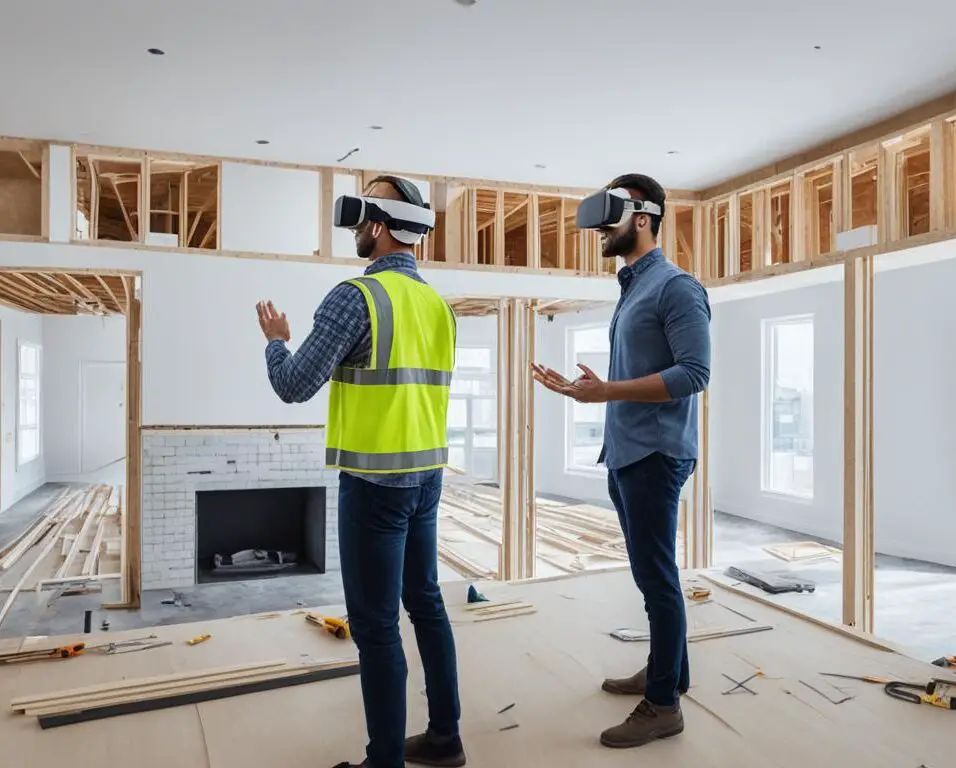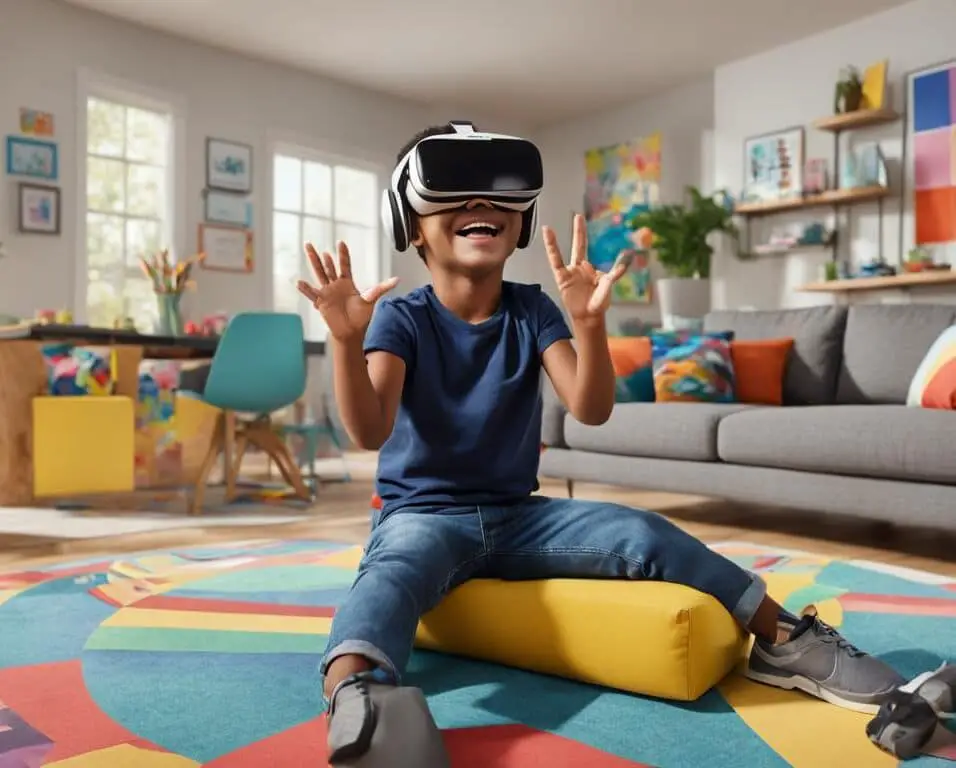Bridging Eras: VR in Contemporary vs. Traditional Home Design
Virtual reality (VR) technology has revolutionized the way we approach and experience home design. In this article, I will explore how VR is bridging the gap between contemporary and traditional home design styles. By utilizing VR tools and immersive experiences, designers and homeowners can visualize and make informed decisions about their spaces. This innovative technology has the potential to transform the way we design, build, and live in our homes.
Key Takeaways:
- VR technology has revolutionized contemporary and traditional home design
- By utilizing VR tools, designers and homeowners can visualize and make informed decisions
- VR enhances the presentation and marketing efforts in showcasing the design
- VR brings new possibilities and enhancements to traditional home design
- VR impacts the decision-making process by helping to avoid costly mistakes
The Benefits of VR in Contemporary Home Design
Virtual reality (VR) technology has brought significant benefits to contemporary home design, revolutionizing the way designers and homeowners approach their projects. By leveraging VR tools and immersive experiences, we can now visualize and make informed decisions about our spaces before construction even begins. Let’s explore the key advantages that VR offers in contemporary home design:
1. Realistic Virtual Walkthroughs
VR enables designers and homeowners to experience a virtual walkthrough of the space, providing a realistic sense of the design. By immersing ourselves in the virtual environment, we can accurately gauge the spatial layout, flow, and functionality of the design. This helps us identify any potential issues or conflicts early in the process, allowing for timely modifications and improvements.
2. Experimenting with Materials, Colors, and Textures
Through VR, designers have the freedom to experiment with different materials, colors, and textures. By virtually applying these elements to the design, we can get a visual representation of how they interact and complement each other. This empowers designers to make informed decisions about the aesthetic aspects of the space, ensuring the final design aligns with their vision.
3. Enhanced Presentation and Marketing
VR also plays a crucial role in showcasing the design to clients or potential buyers. By offering immersive experiences, we can provide a lifelike representation of the design, allowing clients to fully grasp its features and possibilities. This not only enhances the presentation but also improves marketing efforts by creating a memorable and engaging experience for potential stakeholders.
VR enables designers and homeowners to make informed decisions about their spaces, experiment with materials, and create immersive presentations.”
Overall, VR brings a multitude of benefits to contemporary home design. By providing realistic virtual walkthroughs, facilitating experimentation with materials, colors, and textures, and enhancing presentation and marketing efforts, VR propels the design process forward, enabling us to create more immersive and engaging spaces.
How VR Enhances Traditional Home Design
VR technology offers exciting enhancements and possibilities for traditional home design. By utilizing VR tools, designers can recreate historical or traditional architectural styles within a virtual environment, providing homeowners with the opportunity to visualize and experience the unique features and characteristics of these designs.
This immersive experience helps bridge the gap between the past and the present, preserving architectural heritage while incorporating modern elements. With VR, designers can incorporate intricate details and finishes that are challenging to visualize through traditional design methods, ensuring accuracy and precision in the execution of the design.
Imagine being able to virtually step into an iconic Victorian-era home or a medieval castle, exploring the elaborate details and grandeur, all within the comfort of a VR headset. VR technology unlocks a new level of realism and interactivity, allowing designers and homeowners to appreciate and understand the historical significance of traditional design styles.
Moreover, VR enhances the collaboration process between designers and clients. Through shared virtual experiences, designers can gather feedback and make necessary adjustments to ensure the design aligns perfectly with the homeowner’s vision and preferences.
The Benefits of VR in Traditional Home Design:
- Visualization: Virtual reality enables homeowners to vividly experience and explore traditional home designs, helping them make informed decisions and refine their vision.
- Heritage Preservation: VR allows the preservation of architectural heritage, ensuring that traditional design styles are accurately represented and appreciated in modern times.
- Detail-Oriented Design: With VR, designers can focus on intricate details and finishes, ensuring that traditional design elements are faithfully executed.
- Collaboration: VR facilitates collaborative design discussions, where designers and homeowners can immerse themselves in the virtual environment together, fostering better communication and understanding.
VR technology brings a new level of authenticity and immersion to traditional home design, allowing homeowners to truly connect with the past while embracing the advancements of the present. It offers a unique opportunity to blend history with modernity, creating spaces that are visually stunning, emotionally engaging, and deeply personal.
The Impact of VR on Design Decision-Making
VR technology has a profound impact on the decision-making process in home design, allowing designers and homeowners to make informed choices that result in well-executed and aesthetically pleasing spaces. By immersing themselves in a virtual environment, users can explore and experience their design ideas, leading to more accurate and satisfying outcomes.
Enhanced Visualization and Design Collaboration
Through VR, designers can visualize their concepts in a realistic and immersive manner. This enables them to assess different designs, layouts, materials, and finishes before committing to a final plan. By experiencing the space in a virtual environment, designers can identify potential issues, make necessary adjustments, and avoid costly mistakes during the construction phase.
The immersive nature of VR also facilitates collaboration among designers, architects, and clients. They can engage in real-time discussions within the virtual environment, exploring design options and refining the vision together. This collaboration ensures that all stakeholders are on the same page and that the final design meets the expectations and functional requirements of the clients.
Making Informed Choices for Layout, Materials, and Finishes
VR technology empowers designers and homeowners to make informed choices about various aspects of the design, such as layout, materials, and finishes. By seeing the design come to life in a virtual environment, they can assess different options and select the ones that align with their aesthetic preferences and functional needs. This allows for a more personalized and tailored design approach.
For example, VR allows homeowners to visualize how different materials and finishes will look in their spaces, ensuring they are making the right choices for their design vision. They can explore various color schemes, textures, and patterns, enabling them to create harmonious and visually appealing interiors.
VR technology offers designers and homeowners the opportunity to make more informed decisions, leading to well-executed and visually stunning spaces. By experiencing the design in a virtual environment, we can identify potential issues, collaborate effectively, and select the most suitable layout, materials, and finishes.
Real-Time Design Adjustments and Iterations
VR also enables designers to make real-time adjustments and iterations to their designs. They can modify and experiment with different design elements within the virtual environment, allowing for quick and efficient refinements. This iterative process results in more finely-tuned and optimized designs, maximizing the potential of the space.
Furthermore, VR provides designers with the ability to explore alternative design options and assess their impact on the overall space. This iterative approach encourages creativity and innovation, as designers can push boundaries and explore unconventional ideas with ease.
| Benefits of VR in Design Decision-Making | Examples |
|---|---|
| Enhanced visualization of design concepts | Experiencing the layout, materials, and finishes in a virtual environment |
| Improved collaboration among designers, architects, and clients | Real-time discussions and refinements within the virtual environment |
| Ability to make informed choices about layout, materials, and finishes | Visualizing different options and selecting the most suitable ones |
| Real-time design adjustments and iterations | Modifying and experimenting with different design elements |
Through VR technology, designers and homeowners can harness the power of immersive experiences to inform their design decisions. By visualizing the design, collaborating effectively, and making informed choices about layout, materials, and finishes, they can create exceptional spaces that exceed expectations.
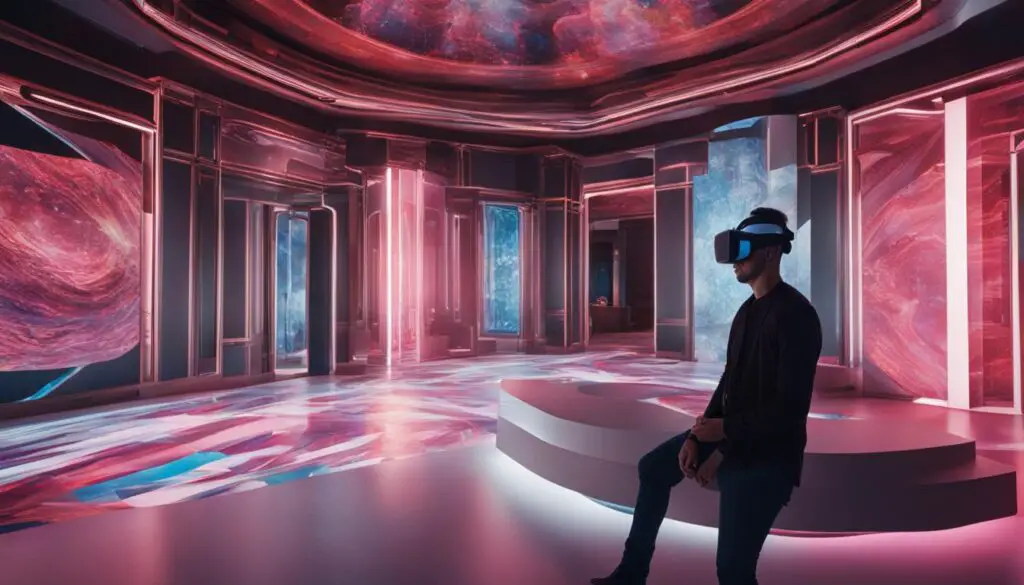
Overcoming Challenges with VR Implementation
Implementing virtual reality (VR) technology in home design comes with its fair share of challenges. In this section, we will explore the obstacles designers and homeowners may face when implementing VR, including high costs, the learning curve associated with VR tools, and technological limitations.
The Cost of VR Technology
One significant challenge in VR implementation is the cost of VR technology and equipment. High-quality VR headsets and software can be expensive, making them inaccessible for some designers or homeowners. The investment required to purchase and maintain VR equipment can be a deterrent, especially for smaller design firms or budget-conscious individuals.
The Learning Curve of VR Tools
Another challenge in utilizing VR for home design is the learning curve associated with VR tools. Designers and homeowners need to familiarize themselves with the software and techniques necessary to maximize the benefits of VR. This, in turn, requires an investment of time and effort to learn and adapt to the new technology effectively.
Technological Limitations
Technological limitations pose another challenge in VR implementation. VR experiences can be demanding in terms of processing power and technical requirements. Complex VR experiences may require high-performance computer systems, which can limit the realism and quality of the virtual environment. These limitations may hinder the seamless integration of VR into the home design process.
Despite these challenges, designers and homeowners can overcome them by exploring cost-effective VR solutions, dedicating time to learn and master VR tools, and adapting their design processes to accommodate technological limitations. By doing so, they can unlock the full potential of VR in creating immersive and transformative home design experiences.
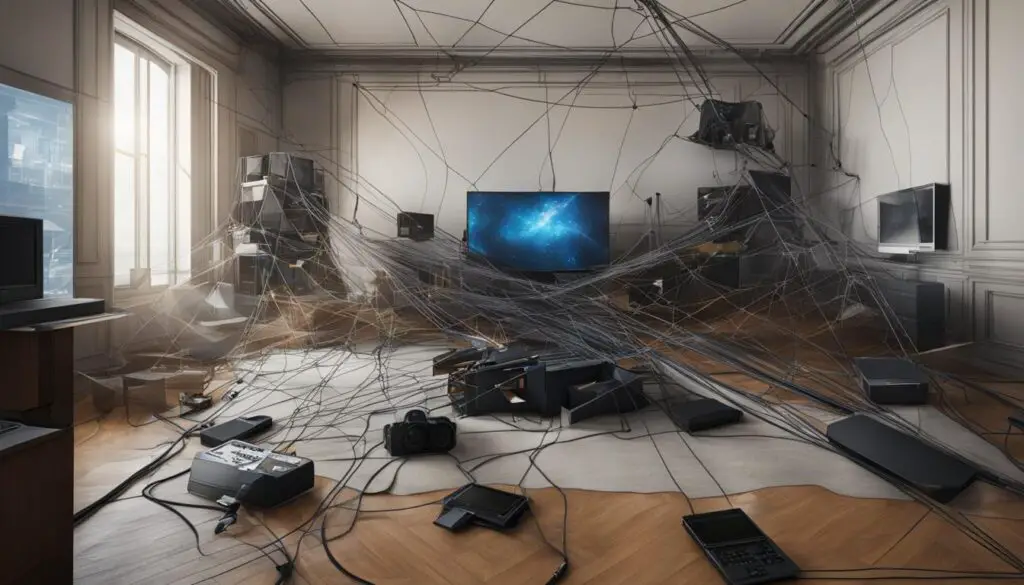
The Future of VR in Home Design
The future of VR in home design holds immense potential for revolutionizing the industry. As technology continues to advance, VR experiences are becoming increasingly accessible and affordable for designers and homeowners alike. This trend opens up exciting new opportunities for utilizing VR in home design projects, making it a powerful tool in shaping the future of the industry.
Moreover, the future of home design is not limited to VR alone. Advancements in augmented reality (AR) and mixed reality (MR) technologies are further enhancing the immersive experiences and blurring the boundaries between the virtual and physical worlds. These emerging technologies will play a vital role in the design process, creating even more interactive and realistic experiences for designers and homeowners.
With the integration of VR and other immersive technologies, designers can push the boundaries of creativity and envision spaces in ways that were previously unimaginable. The ability to walk through a virtual environment and make design choices in real-time allows for a more intuitive and dynamic design process. Homeowners can fully immerse themselves in their future spaces, enabling them to visualize and personalize every aspect of their designs.
This shift towards immersive technologies not only empowers designers and homeowners but also brings us closer to a future where virtual and physical design seamlessly coexist. From concept development to material selection and final execution, VR and other immersive technologies offer a comprehensive solution for transforming home design into a truly interactive and engaging experience.
As we look ahead, the future of VR in home design is filled with limitless possibilities. With continued advancements and increasing accessibility, we can expect to see a surge in the adoption of VR by designers and homeowners. The integration of AR and MR technologies will further enhance the immersive experiences, elevating the design process to new heights of creativity and realism.
Let us now explore some exciting case studies that highlight the successful implementation of VR in home design, showcasing its transformative powers in real-world projects.
Case Studies: Successful Implementations of VR in Home Design
Several real-world examples demonstrate the successful implementation of VR in home design. One notable case study is the renovation of historical homes using VR technology. Designers have employed VR to recreate the original architectural features and visualize design options that align with the heritage of the property. This approach allows homeowners to experience the historical ambience and make design decisions that honor the property’s legacy.
Another compelling example is the utilization of VR in the pre-construction phase of new residential developments. Homebuyers can immerse themselves in a virtual environment and explore their future homes. This interactive experience enables them to customize various elements such as layout, materials, and finishes. By making informed decisions through VR, homebuyers set realistic expectations and are actively involved in the design process.
“VR technology offers an unprecedented level of engagement and personalization to homeowners. It allows them to truly envision their dream homes before construction even begins, leading to higher satisfaction levels and reduced change orders.” – Jane Thompson, Interior Designer
These case studies showcase the effectiveness and potential of VR in transforming the home design industry. By leveraging VR technology, designers and homeowners can collaborate more effectively, resulting in spaces that are not only visually appealing but also tailored to personal preferences and functional requirements.
| Case Study | Implementation | Key Benefits |
|---|---|---|
| Renovation of Historical Homes | Recreation of architectural features and design visualization | Preservation of heritage, informed design decisions |
| Pre-construction Phase of Residential Developments | Virtual exploration and customization of future homes | Enhanced buyer experience, realistic expectations |
Conclusion
Virtual reality (VR) has emerged as a game-changer in the world of contemporary and traditional home design. By bridging the gap between these two styles, VR is revolutionizing the way designers and homeowners approach their spaces. Through immersive experiences and realistic simulations, VR enables them to make informed decisions, visualize their designs, and create more engaging and personalized homes.
Despite the challenges associated with implementing VR in home design, its future looks promising. Advancements in accessibility and the emergence of new immersive technologies are paving the way for wider adoption. As VR continues to evolve, it will undoubtedly have a profound impact on the way we approach and experience home design, transforming the industry in unprecedented ways.
The impact of VR in contemporary and traditional home design cannot be undermined. By offering an immersive and lifelike experience, VR allows designers and homeowners to explore different design possibilities, experiment with materials and finishes, and ensure that the final outcome aligns with their vision. It empowers them to create spaces that truly reflect their style and preferences.
In conclusion, VR is revolutionizing the world of home design, blurring the boundaries between the virtual and physical realms. This cutting-edge technology has the potential to reshape the industry, enabling us to push the boundaries of creativity and innovation. As VR continues to evolve and become more accessible, the possibilities for creating extraordinary homes are only limited by our imagination.
FAQ
What is virtual reality (VR) technology?
Virtual reality (VR) technology is a digital simulation that allows users to experience and interact with a virtual environment. It typically involves wearing a VR headset that immerses the user in a 3D visual and audio experience, giving them the sensation of being physically present in a virtual space.
How does VR revolutionize contemporary and traditional home design?
VR technology revolutionizes contemporary and traditional home design by providing designers and homeowners with immersive experiences and realistic simulations. This enables them to visualize and make informed decisions about their spaces before construction even begins, bridging the gap between different design styles and creating more engaging and personalized homes.
What are the benefits of using VR in contemporary home design?
The benefits of using VR in contemporary home design include the ability to experience a realistic virtual walkthrough of the space, experimentation with different materials and colors, enhanced presentation and marketing efforts, and better decision-making about layout and aesthetics.
How does VR enhance traditional home design?
VR enhances traditional home design by recreating historical or traditional architectural styles in a virtual environment. This allows homeowners to visualize and experience the unique features and characteristics of these designs, preserving architectural heritage while incorporating modern elements. VR also facilitates the incorporation of intricate details and finishes that are challenging to visualize with traditional methods.
How does VR impact the decision-making process in home design?
VR impacts the decision-making process in home design by allowing designers and homeowners to experience the design in a virtual environment. This helps them make more informed choices about layout, materials, and finishes, avoiding costly mistakes and ensuring that the design aligns with their desired aesthetic and functionality.
What are the challenges associated with implementing VR in home design?
Some challenges associated with implementing VR in home design include the cost of VR technology and equipment, the learning curve associated with using VR tools effectively, and potential technological limitations that may impact the realism and quality of the virtual environment.
What is the future of VR in home design?
The future of VR in home design looks promising as technology continues to advance. VR experiences are becoming more accessible and affordable, opening up opportunities for more designers and homeowners to utilize VR in their projects. Advancements in augmented reality (AR) and mixed reality (MR) technologies are further enhancing the immersive experience and blurring the boundaries between the virtual and physical worlds.
Are there any real-world examples of successful VR implementation in home design?
Yes, there are several real-world examples of successful VR implementation in home design. These include the use of VR in the renovation of historical homes to recreate original architectural features, as well as the use of VR in the pre-construction phase of new residential developments, allowing homebuyers to customize their future homes in a virtual environment.



